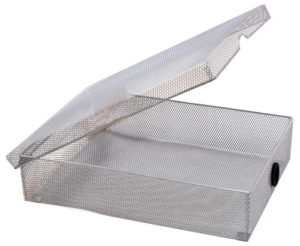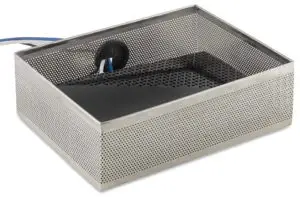Bluetooth technology provides an easy and convenient way of communication. It allows individual devices to establish a connection and be able to communicate with each other and share data. Bluetooth uses Wi-Fi networks to share data rather than using the internet.
As Bluetooth transmits data from one device to another, it emits dangerous radio frequency (RF) radiation. Wi-Fi devices also emit RF as they send and receive data from multiple devices. You may wonder, is Bluetooth safer than Wi-Fi?
Bluetooth technology emits low EMF radiation compared to radiation emitted through Wi-Fi technology.
Though both Bluetooth and Wi-Fi rely on wireless communication and emit radio frequency signals as they transmit data, Bluetooth devices radiate at lower levels than Wi-Fi. This is because Bluetooth connects to devices within a very short range, usually 10 meters, in order to share data, while Wi-Fi provides high-speed internet access to devices. As a result, the Wi-Fi device emits high RF signals while transmitting data.
Bluetooth uses a wireless technology standard to send and receive data over short distances. This means that it has a wireless transmitter and receiver. Bluetooth also transmits data using the microwave frequency spectrum range of 2.4 GHz to 2.4835 GHz, which is similar to that used by microwave ovens.
The wireless RF radiation emitted by Bluetooth devices such as headsets and other wireless technologies is also known as microwave radiation. Radiation frequencies from microwaves have short wavelengths and oscillate rapidly.
Because of the rapid oscillations and short wavelengths of the microwave frequency, the radiation can penetrate through an individual’s tissue.
This makes the RF radiation and EMF radiation emitted very dangerous to your health. For example, higher exposure to these types of radiation results in an induced stress response.
To understand how Bluetooth is safer than Wi-Fi, let’s look at how each works.
How Radio Waves Work in Bluetooth Technology
Bluetooth uses a small-area networking standard that transmits data in two levels:
- A physical level that provides a connection establishment agreement using RF standard.
- A protocol-level where connected devices have to agree on how to transfer data bits, the number of bits to be sent per time, and ensuring the number of bits sent is the same with what is received.
The Bluetooth technology uses a wireless network to transmit data to multiple devices through low-power radio waves. It uses a communication frequency band of 2.45 GHz (usually a microwave frequency spectrum between 2.4 GHz and 2.4835 GHz).
There are other devices that rely on this spectrum frequency band to communicate. Some of these devices include garage door openers, cordless phones, baby monitors, etc. As a result, the devices can interfere with each other’s signals.
To avoid this interference, Bluetooth sends out weak signals at a frequency band of about 100 milliWatts. The low power radio waves limit Bluetooth range up to 200 meters thus reducing any chance of interference with other communicating devices.
This makes it possible for the Bluetooth device to communicate with other devices within a distance of 10 meters simultaneously. These Bluetooth devices will not interfere with each other because they use the ‘spread-spectrum frequency hopping’ technique to communicate with each other. This technique ensures no two Bluetooth devices are transmitting at the same frequency at the same time.
In addition, each of the Bluetooth devices can rely on the available 79 frequencies within the designed range. The devices can hop from one frequency to the next on a regular basis.
This makes it possible for the Bluetooth transmitters to change frequency up to 1600 times per second. This explains how multiple Bluetooth devices rely on low-power radio waves to utilize the limited radio spectrum frequency.
Once all of the Bluetooth devices are within the range, they can communicate with each other through sharing data or voice communication. As the devices communicate, they create a personal area network (PAN) such as a Bluetooth connection between your smartphone and laptop or your television. As the devices communicate with each other they emit little amounts of radio waves compared to the amount of radio waves emitted by Wi-Fi devices.
Bluetooth headsets like those that you wear around your ear usually radiate at a rate of 0.23 W/kg (watts per kilogram). Other Bluetooth headsets have higher radiation rates than the recommended SAR for cell phones.
The headsets are suitable for transmitting small chunks of data. Because of that, Bluetooth is designed to transmit light weight data with bandwidth of 1 Mbps.
How Radio Waves Work in Wi-Fi Networks
Wi-Fi devices use a 802.11 wireless network standard to connect to each other. Just like the Bluetooth and other wireless devices like cell phones and televisions, Wi-Fi devices use radio waves to transmit data.
The wireless devices create two-way communication. They do this by:
- Using the computer’s wireless adapter to translate the sent data into radio signals and transmit the data via the antenna.
- Using a wireless router to receive and decode the signals sent to them. Afterward, the router sends the decoded information to the internet via a wired Ethernet connection.
After the router sends the information to the internet, the router receives back the information from the internet. The information is then translated into radio signals and sent back to the wireless adapter of your computer.
The Wi-Fi devices transmit at the frequency range between 2.4 and 5 GHz. This frequency is much higher than that used by Bluetooth devices, allowing the Wi-Fi device to send more data over the spectrum band.
The 802.11 network standard transmits data in two ways:
- The 802.11a transmits 5 GHz of data at a speed of 54 megabits per second using the “orthogonal frequency-division multiplexing” technique. This makes it possible to split the radio waves into several sub-signals to transmit data before they reach the destination. Each of these sub-signals increases the amount of radiation emitted as the devices transmit data.
- The 802.11b transmits at a frequency range of 2.4 GHz radio spectrum and can transmit data at a speed of 11 megabits per second.
- 802.11ac standard transmits between a spectrum band of 2.4 and 5 GHz. This spectrum band is less prone to electromagnetic interference from other devices. It can transmit data up to 50 megabits per second and allow transmission over several spatial streams. It is sometimes referred to as the 5G Wi-Fi and due to its multiple streams, it has very high throughput.
These Wi-Fi RF signals hop between three different frequency bands. This allows multiple devices to have the same wireless connection but with less interference.
The Wi-Fi connection forms a wide area network (WAN) that allows you to connect to a wide range of devices.
The antenna in Wi-Fi routers broadcast high-frequency radio signals in all directions to devices within a radius of between 100 to 500 feet. Broadcasting of the high-frequency radio waves through the Wi-Fi transmitter exposes you to high radiation similar to having a miniature radio station in your home.
The Wi-Fi standards transmit huge volumes of data such as videos and photos from 347 Mbps to 1.3 Gbps.
The high-frequency radio waves result from signals of all wireless devices within the appropriate range.
The Wi-Fi devices connected to the Wi-Fi router emit high-levels of RF radiation due to the use of multiple sub-radio frequency signals.
So Is Bluetooth Safer Than Wi-Fi?
Radiation emitted by Bluetooth devices is safer compared to the high-level radiation emitted by Wi-Fi devices. Although both devices rely on radio frequency signals to transmit data, we have seen that Bluetooth devices use very low power variations of up to 100 mW while Wi-Fi uses high-power variations of up to 500 mW.
The Bluetooth transfer capacity is very slow compared to the high internet transfer speed. Bluetooth also sends very weak signals to the spectrum frequency band to avoid any interference while Wi-Fi devices use multiple spatial streams to avoid interference. This results in high radiation throughput compared to that emitted by Bluetooth devices.
When using Bluetooth, the radio frequency radiation (RFR) dissipates at a rate proportional to the distance between the transmitting devices. The Bluetooth transmission power is lower than that of Wi-Fi devices.
In most cases, the Bluetooth device is idle and this not only preserves the battery life of your Bluetooth device but it also reduces your radiation exposure. On the other hand, your Wi-Fi device is always on whether transmitting or not. The Wi-Fi devices also keep on searching for the available network to connect to and be ready to transmit data. The constant searching of the available network trying to connect increases the amount of radiation emitted. It also increases your risk of exposure to electromagnetic radiation.
Therefore, both devices do emit a lot of radio frequency radiation, but Wi-Fi devices also emit high-levels of RF radiation. Individuals who have electromagnetic hypersensitivity are more affected by radio waves from Wi-Fi devices than those from Bluetooth devices.
Radio Frequency Dangers
All devices using Bluetooth technology and a Wi-Fi network emit wireless radio wave frequency (RF), a type of microwave radiation. These microwave radiation frequencies are suitable for data and voice communication from Bluetooth headsets. The high wattage generated by microwaves can cook your dinner plate or plastic container.
Long-term exposure to bluetooth radiation and radiation from Wi-Fi devices have negative effects on your health. The 0.23 W/kg emitted via a Bluetooth headset is higher than the recommended RFR exposure level. Continuous exposure to high levels of RF will allow it to pass the blood-brain barrier. Watch this video to see how bluetooth radiation is dangerous to your health:
A Bluetooth headset exposes you to microwave radiation that affects your brain, ears and even eyes. Microwave radiation exposure is also linked to brain tumors, cancer, leukemia, birth defects and miscarriage.
High speed Wi-Fi internet connections are linked to electromagnetic hypersensitivity syndrome (EHS). If you have high sensitivity and go to specific Wi-Fi hotspot areas, you may experience itchy skin, headaches, fatigue, nausea, muscle pains or even feel like your skin is burning. Each person can experience different symptoms based on the signal strength.
How to Reduce Risk of Exposure from Wi-Fi and Bluetooth Devices
When buying Bluetooth devices make sure you buy anti-radiation bluetooth headphones to help you reduce the risk of exposure to RF radiation.
When not using wireless internet, you should turn off the Wi-Fi router. Turning off the router will prevent broadcast of high-frequency wireless signals from the router’s antenna. As a result, radio waves emitted by the routers are reduced. Even when not using the internet, the Wi-Fi router continuously broadcasts signals and wireless devices within the range can receive the signal. Even when going to sleep, avoid leaving the Wi-Fi router on.
Alternatively, switch off the bluetooth option or wireless option in your devices and connect the devices using cables. A wired connection reduces the amount of radiation being emitted by the devices. If the router has to be on throughout the day and night, you should invest in router protection guards and covers to reduce your exposure to the radiation.
You can read my detailed article on how to minimize Bluetooth exposure here.
Products That Block RF Radiation at Home and Office
Wi-Fi Router Guard
This is a great tool that blocks about 85% of RF radiation and EMF radiation generated by Wi-Fi devices in your home or office. The cover is made from proven Faraday cage metals that block the radio frequency waves.
The metal mesh is made of highly conductive metal, either steel or copper, to block electromagnetic radiation and radio frequency waves. The cover is simple and easy to use. It is mostly designed for smaller size routers that measure 12 x 9 x 3 inches.
If you have a larger router, you can go for the large Wi-Fi router guard.
The large Wi-Fi router guard can store other wireless devices in the house. For example, if you have baby monitors or any other Wi-Fi transmitting device, you can put it inside this router guard to reduce the amount of radiation emitted.
Learn more about Wi-Fi router guards from my detailed article: Wi-Fi Router guard to improve EMF protection.
Wi-Fi Router Cover
This Wi-Fi RF radiation shield blocks radiation from Wi-Fi routers up to 90% without affecting the routers performance and download speed. The cover is custom made featuring a sleek and shiny design. The stainless steel material used in building the cover reduces transmission of EMF radiation and it is designed to ensure you’re safe.
The cover has a 2 inch cut out to provide enough room for passing the Ethernet cables and any other cables being connected to the router.
The cover measures 12 x 9 x 4 inches providing enough room to fit a wide range of routers in the market.
It is easy to install and it protects you from high levels of EMF being emitted from your Wi-Fi devices.
Summary
Bluetooth headsets and speakers use RF signals to play music. Two cell phones connected via Bluetooth to share data emit RF signals. Just like the cell phones, Wi-Fi routers use RF energy, which is a form of electromagnetic radiation (EMF) to connect your computer, television, smartphone and other smart devices to the wireless internet. Any other Wi-Fi connected device at home or office uses the radio frequency waves to transmit and receive wireless signals.
Wi-Fi devices have different power variations ranging from 30 mW to 500 mW depending on the quality of the signal and the device while Bluetooth devices have power variations up to 100 mW. This makes Bluetooth very weak compared to the Wi-Fi network.
The Bluetooth dangers are 10 to 100 times less compared to radiation dangers from Wi-Fi devices. If you have more than 5 Wi-Fi devices being used each day, then the Wi-Fi radio energy emitted is very high and can be comparable to the radio waves emitted by your cell phone.
There are various dangers associated with RFR and it’s up to you to come up with ways to reduce the risk of exposure.
The intensity of radiation from the different device technologies determines your risk of exposure. Minimizing exposure to both Bluetooth and Wi-Fi radiation will reduce the side effects associated with these types of radiation. When buying bluetooth headsets, make sure to buy anti-radiation bluetooth headphones.
Anti-radiation EMF protection shields like the Wi-Fi router guard and Wi-Fi router cover can be used to reduce the risk of exposure.




